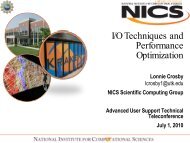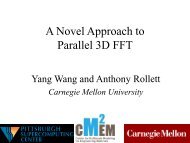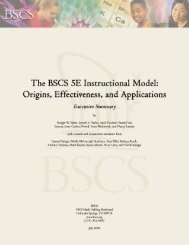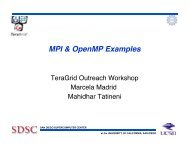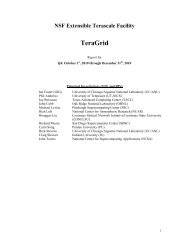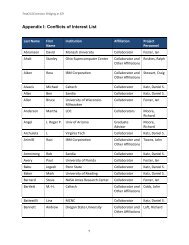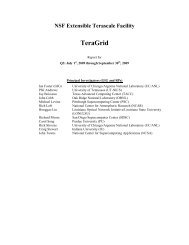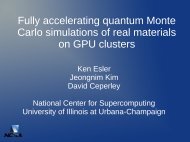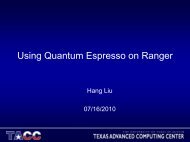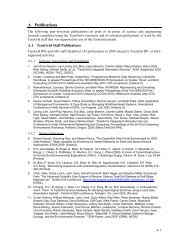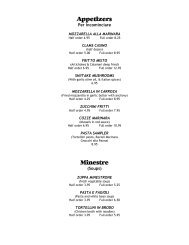TGQR 2010Q2 Report.pdf - Teragridforum.org
TGQR 2010Q2 Report.pdf - Teragridforum.org
TGQR 2010Q2 Report.pdf - Teragridforum.org
You also want an ePaper? Increase the reach of your titles
YUMPU automatically turns print PDFs into web optimized ePapers that Google loves.
significantly improve the user experience and ensure better support for another graduate class in<br />
the fall semester 2010.<br />
UC/ANL: The UChicago/Argonne RP hosts and provides operating system, security and other<br />
software support for the two machines that act as the production and development Visualization<br />
Gateway resources, as well as the machine that serves the Open Life Science Gateway. The<br />
UChicago/Argonne team has continued work on their gadget-workflow framework. Initial work<br />
on a package builder for the framework, which enables developers to reuse the framework to plug<br />
in their domain-specific workflows has been completed. To simplify the handling of input, two<br />
intuitive and easy-to-use GUIs were developed. Users can simply type in command-line examples<br />
or upload their Swift scripts to create XML descriptions for their applications. Also implemented<br />
was support for determining output products from workflow descriptions and representing them<br />
in the portal graphically. The output view also includes an output file browser, execution<br />
parameters view, and workflow progress view. Users can customize the output views when<br />
defining their workflows by selecting the appropriate output files and modifying the general<br />
transform style sheets. Based on their experience of developing the gadget-workflow space, the<br />
UChicago/Argonne RP team wrote the paper "Accelerating Science Gateway Development with<br />
Web 2.0 and Swift" which was submitted, and accepted, to the TeraGrid 2010 Conference.<br />
5 Users and User Support<br />
User support in the TeraGrid comprises interlocking activities in several project areas:<br />
documentation, allocations and accounting services in the User Facing Projects and Core<br />
Services area (Section 6 of this report); the TeraGrid Operations Center in the Networking,<br />
Operations and Security area (Section 8); user outreach and training in the Education, Outreach<br />
and Training/External Relations area (Section 10); and the Frontline User Support and Advanced<br />
User Support services described in the current section. In addition, specialized user support<br />
services are provided by staff from the Science Gateways (Section 4) and Data and Visualization<br />
(Section 7) areas. The synergy of all these aspects of user support is coordinated by the User<br />
Interaction Council which consists of the GIG Director of Science and the directors of the above<br />
mentioned areas.<br />
5.1 Highlights<br />
The User Support (US) and Advanced User Support (AUS) staff continued their highly rated<br />
services for TeraGrid users at every level. As needed, US and AUS staff collaborated with the<br />
Data and Visualization, Science Gateways, EOT and User-Facing Projects and Core Services<br />
(UFC) staff to provide comprehensive support for TeraGrid users.<br />
An important collaboration between UFC and US staff has resulted in the final test version of a<br />
new “User Services Contact Administration and Logging” LifeRay portlet, which will enable US<br />
staff to manage the assignment of personal contacts not only to TRAC grant awardees after each<br />
quarterly meeting, but also to Startup and Education awardees whose usage patterns indicate a<br />
possible need for proactive assistance. Building on an application previously developed by UFC<br />
for AUS project planning and reporting, this web page will also enable consultants to take notes<br />
of their interactions with the users, greatly enhancing the User Engagement function of the User<br />
Champions program. The application is now in final testing, and has been used for assigning<br />
contacts to the awardees of the June 2010 TRAC meeting.<br />
Based on work done on ASTA and other AUS projects, AUS staff continued to present papers at<br />
conferences, and submit and publish journal papers. Multiple AUS and US staff were involved in<br />
<strong>org</strong>anizing the TG10 conference. This included submitting abstracts/papers/tutorials for the<br />
31



